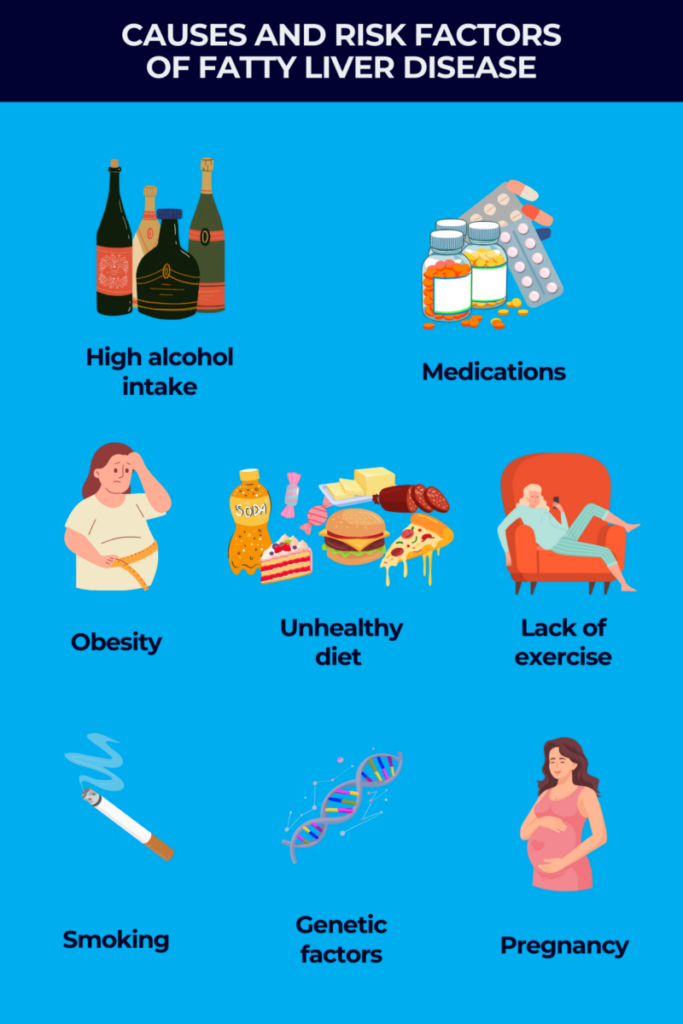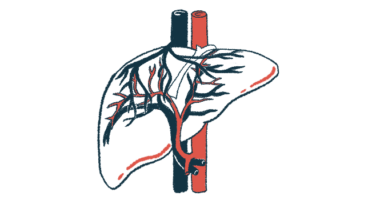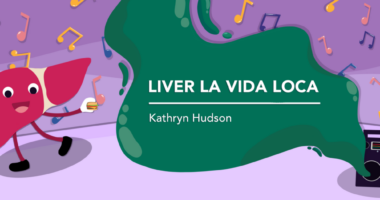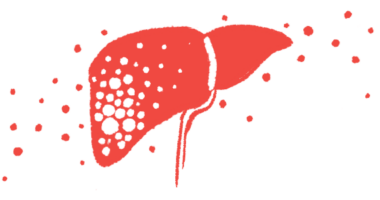Fatty liver disease causes and risk factors
Last updated March 18, 2025, by Lindsey Shapiro, PhD

There are a number of possible causes of fatty liver disease, a group of conditions characterized by steatosis, or the abnormal accumulation of fat in the liver. Alcohol consumption, medication use, lifestyle, genetics, and other health conditions can all contribute to the disease.
Still, it is not always clear why fat accumulates in the liver of some people but not others, and it is possible to develop fatty liver disease — now more formally called steatotic liver disease (SLD) — even in the absence of known risk factors.
Many fatty liver disease risk factors are modifiable, meaning there are lifestyle adjustments that can be made to help prevent it and promote liver health, including eating a healthy diet, exercising regularly, maintaining a healthy weight, and cutting back on alcohol consumption. Once a person receives a diagnosis of fatty liver disease, introducing these changes early enough might also help reverse the disease.
Understanding the types of fatty liver disease
In general, fatty liver disease is believed to arise when certain precipitating factors — including alcohol, drugs, pregnancy, or metabolic conditions — lead to changes in the liver that affect how fatty molecules are produced, stored, and/or broken down.
This ultimately drives the buildup of fatty deposits that characterizes steatosis. The specific factors that trigger these liver changes vary by disease type, and in some cases doctors don’t know what causes fatty liver disease.
Traditionally, fatty liver disease was classified into two main types based on whether or not it was caused by heavy alcohol consumption: alcoholic fatty liver disease (AFLD) and nonalcoholic fatty liver disease (NAFLD).
Under the same 2023 nomenclature update that led to fatty liver disease being now known as SLD, AFLD is now called alcohol-associated liver disease (ALD). Also, most cases of NAFLD are now classified as metabolic dysfunction-associated steatotic liver disease (MASLD), where steatosis is closely linked to cardiometabolic risk factors such as obesity, diabetes, high blood pressure, or high levels of fats (cholesterol or triglycerides) in the blood.
Other types of fatty liver disease include:
- metabolic dysfunction and alcohol-associated liver disease, or MetALD, which is associated with both cardiometabolic factors and moderate alcohol intake
- drug-related SLD, which develops as a side effect of medications
- acute fatty liver of pregnancy, which develops during pregnancy
- cryptogenic SLD, where the exact cause cannot be determined.
While some forms of fatty liver disease such as ALD or drug-related SLD have a distinct identifiable cause, researchers don’t know exactly what causes MASLD or acute fatty liver of pregnancy.
It’s also not known exactly why some MASLD patients progress to metabolic dysfunction-associated steatohepatitis (MASH), where steatosis gives rise to inflammation and tissue scarring in the liver. However, some risk factors have been identified for both MASLD and MASH.
Lifestyle and behavioral causes and risk factors
There are a number of possible fatty liver disease causes, including certain lifestyle, behavioral, and environmental factors:
- alcohol consumption
- medication and drug use
- poor diet and weight management
- smoking.
Alcohol and medications
The liver is responsible for processing most substances put in the body, including alcohol and medications. Use or overuse of certain substances can lead to liver changes that promote steatosis.
Heavy alcohol use is the cause of ALD. When a person drinks more than the liver can process, the organ becomes damaged and its ability to produce and process fatty molecules is altered. Moderate alcohol consumption is also a contributing factor of MetALD.
Likewise, some medications can lead to molecular and metabolic changes in liver cells that drive steatosis for some people. There are many drugs and medications that can cause fatty liver disease or aggravate steatosis in fatty liver disease patients, including:
- nonsteroidal anti-inflammatory drugs to relieve pain and fever such as aspirin and ibuprofen (the active agent in Advil and Motrin IB)
- anti-inflammatory corticosteroids
- tetracyclines, a class of antibiotics
- amiodarone, a medication for irregular heartbeat sold under the brand name Pacerone, among others
- certain cancer medications, including methotrexate (sold as Jylamvo, among others)
- valproate, an epilepsy medication available as generics only
- certain HIV medications, including zidovudine (sold as Retrovir, among others)
- cocaine.
Unhealthy diet, lack of exercise, and obesity
Lifestyle factors that can contribute to metabolic problems are also believed to be drivers of fatty liver disease, particularly MASLD and MetALD.
Obesity is a leading risk factor for MASLD, with up to 90% of people who are obese developing MASLD. There are a number of possible ways that obesity might lead to fatty liver disease, including through insulin resistance, where the body does not respond properly to insulin, the hormone that regulates the levels of blood sugar (glucose). In turn, this impacts the way the liver stores fat. Obesity is also associated with inflammation, which contributes to fat accumulation in the liver.
Consuming an unhealthy diet and lack of exercise are major contributors to obesity, and are therefore associated with an increased risk of fatty liver disease.
While there are no specific foods that cause fatty liver disease, when a person consumes more calories (a measure of energy) than needed, some of that excess is stored in the liver. Research indicates that high-calorie diets — especially those rich in saturated and trans fats and cholesterol — as well as those rich in fructose, a natural sugar commonly added to processed foods and soft drinks, might contribute to liver fat accumulation.
Normally, exercise helps burn fat to produce energy. A more sedentary lifestyle also promotes fat accumulation in liver cells, and can contribute to insulin resistance and inflammation that drive fatty liver disease.
Also, malnutrition and rapid weight loss, which are thought to cause liver stress that affects fat metabolism, are uncommon nonalcoholic fatty liver disease causes.
Smoking
A growing number of studies support smoking as a risk factor for fatty liver disease development and progression, as it may lead to liver cell damage and metabolic changes that contribute to liver fat accumulation.

Genetic risk factors
Increasing evidence suggests that certain genetic factors may make individuals more susceptible to developing fatty liver disease, so a family history of the disease can also increase a person’s risk.
Some genetic factors, particularly genetic variants in the PNPLA3 gene, have been associated with an increased susceptibility to ALD. Drug-induced fatty liver disease may also be influenced by genetic mutations that affect how medications are processed in the body.
In addition, a number of genetic mutations have been linked to the development of MASLD/MASH, but none are established as a definitive cause. Genes linked to the condition are often involved in fat and glucose metabolism, and include:
- PNPLA3
- TM6SF2
- GCKR
- MBOAT7.
Genetic factors may also help explain why fatty liver disease is seen more often in certain racial and ethnic groups. For example, Hispanic individuals, who have the highest MASLD prevalence in the U.S., are found to have more genetic risk mutations linked to the disease.
While researchers don’t know why some women develop temporary fatty liver disease during pregnancy, genetic mutations that lead to a deficiency in an enzyme called LCHAD are associated with the disease.
Rare genetic diseases that affect the way the body uses or stores fat, including lipodystrophies, Wilson disease, and familial hypobetalipoproteinemia, can also be uncommon causes of fatty liver disease.
Other risk factors
Besides the above mentioned lifestyle, behavioral, and genetic factors, a number of other risk factors of fatty liver disease have been identified, and these may differ between disease types.
For instance, being female may increase the risk that a frequent alcohol user will develop ALD.
A variety of other factors and conditions are known to increase the risk of fatty liver disease, particularly MASLD, including:
- type 2 diabetes or high blood sugar
- insulin resistance
- abnormal levels of fats in the blood, including cholesterol or triglycerides
- high blood pressure
- metabolic syndrome, characterized by at least three of the following traits: large waist size, high blood pressure, elevated triglycerides, cholesterol abnormalities, or high blood sugar
- age older than 50
- polycystic ovary syndrome
- obstructive sleep apnea
- low levels of certain hormones, including thyroid, pituitary, and/or sex hormones
- changes in gut microbiota, the community of microbes that live in the gut
- exposure to certain toxic chemicals.
Scientists don’t know exactly why some people with MASLD progress to MASH, but many of the above risk factors also increase the risk of MASH. MASH may also be more likely in postmenopausal women and in people who are Hispanic or Asian.
Differences between ALD and MASLD
The main difference between ALD and MASLD — the two main forms of fatty liver disease — is that ALD is caused by heavy alcohol consumption, while MASLD is not associated with alcohol use but instead linked to cardiometabolic risk factors. Still, they can have some overlapping risk factors, including smoking and certain genetic mutations.
In addition, a combination of metabolic factors and moderate alcohol consumption can contribute to MetALD, which reflects the spectrum of fatty liver disease between MASLD and ALD. In MetALD, the dominant driver of the disease may be metabolic factors for some patients, and alcohol consumption for others, and this may change over time.
MASLD and ALD can ultimately cause many of the same fatty liver disease symptoms, but treatment varies by type. Fatty liver disease caused by alcohol is mainly managed by stopping drinking, while treating MASLD usually involves other lifestyle adjustments to manage cardiometabolic risk factors.
Preventing fatty liver disease
How to prevent fatty liver disease depends on its underlying cause, but in general, the best way to prevent it is to make lifestyle changes that will support liver and overall health, including:
- eating a healthy diet
- exercising regularly
- maintaining a healthy weight
- taking necessary medications for managing diabetes, high cholesterol, or other metabolic conditions
- abstaining from alcohol, tobacco, and other substances that can damage the liver
- managing stress
- getting enough sleep
- taking medications as prescribed and not using more than the recommended dose.
Some evidence suggests that certain dietary supplements, such as omega-3 fatty acids, could help protect the liver and reduce fat accumulation, but more research is still needed. People should always talk with their doctor before using any supplements because they may not be safe in every case.
In addition to helping protect the liver against fat accumulation, healthy lifestyle changes may also help prevent diseases caused by fatty liver, which affect other parts of the body, such as the cardiovascular system and the kidneys.
Can fatty liver disease be reversed?
Upon a fatty liver disease diagnosis, patients should talk with their healthcare provider about whether and how fatty liver disease can be reversed.
Many of the lifestyle changes recommended for preventing fatty liver disease are the same as those used to treat the condition, including losing weight and exercising. Eating an appropriate fatty liver disease diet and knowing which foods to eat or avoid is also important.
The liver is very resilient, and when these changes are initiated early in the course of MASLD, it’s possible to reverse the disease entirely. However, the further MASLD progresses, the harder it becomes to entirely restore liver function.
That’s why reaching an early diagnosis and adopting healthy lifestyle habits as soon as possible is important for ensuring the best possible outcomes in fatty liver disease.
Liver Disease News is strictly a news and information website about the disease. It does not provide medical advice, diagnosis or treatment. This content is not intended to be a substitute for professional medical advice, diagnosis, or treatment. Always seek the advice of your physician or other qualified health provider with any questions you may have regarding a medical condition. Never disregard professional medical advice or delay in seeking it because of something you have read on this website.
Recent Posts
- Less invasive Kasai surgery works better for infants with BA: Study
- US states, doctors split with CDC on hepatitis B shots for newborns
- PSC-IBD study shows need for regional management guidelines
- Staying on top of MASH may mean not staying on the transplant list
- Common virus may play a role in ICP development, study finds





